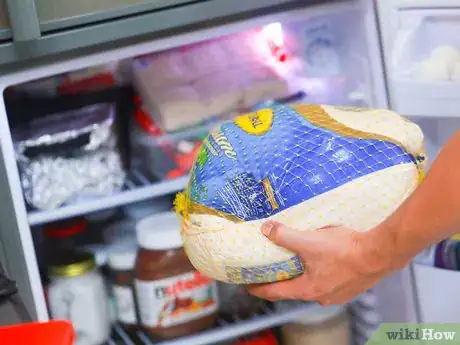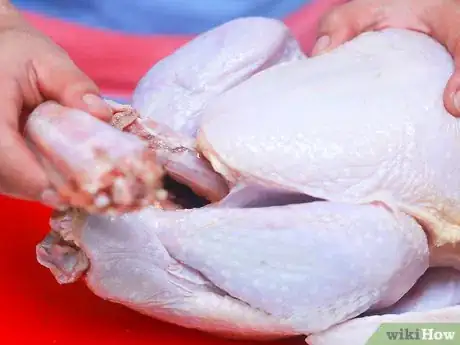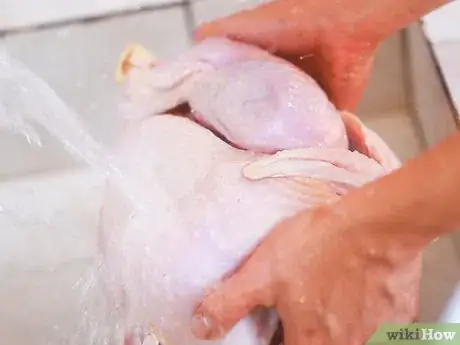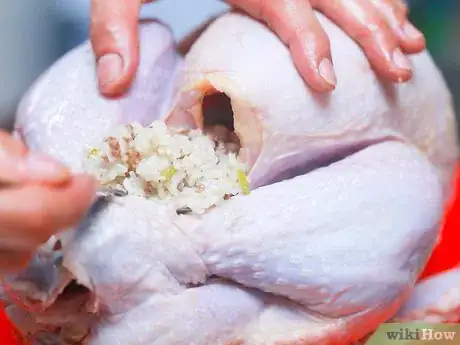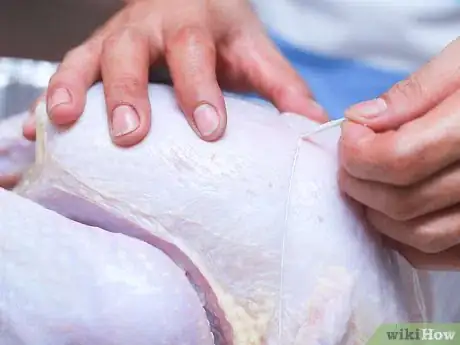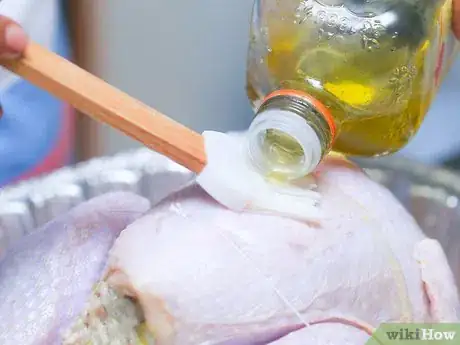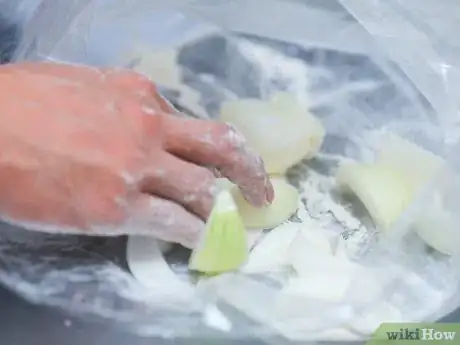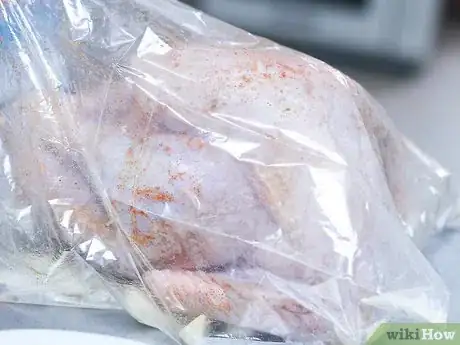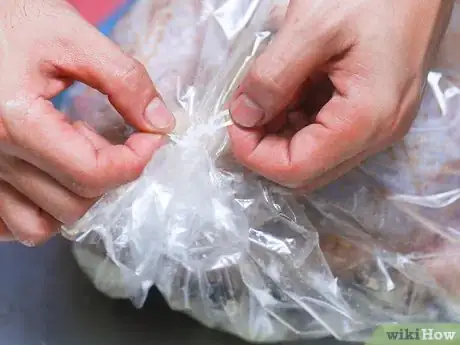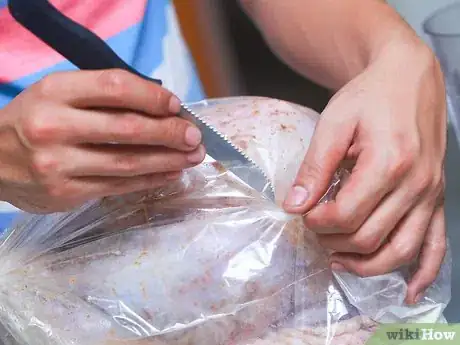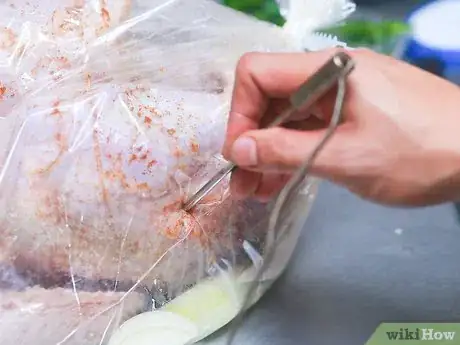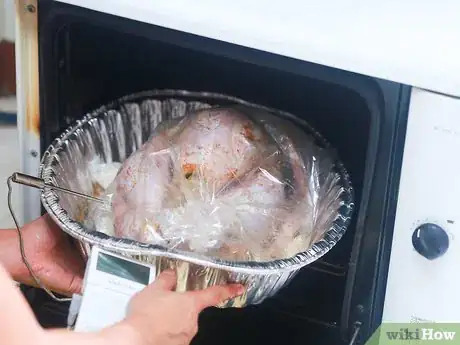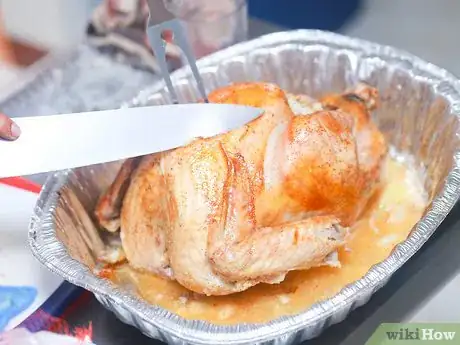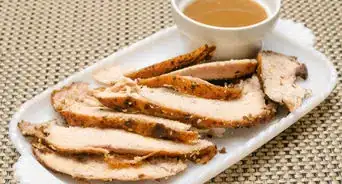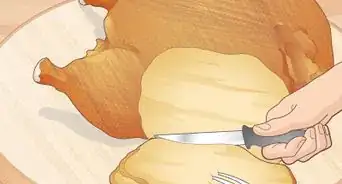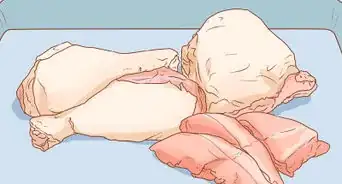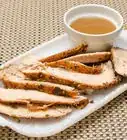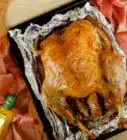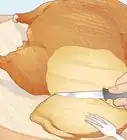wikiHow is a “wiki,” similar to Wikipedia, which means that many of our articles are co-written by multiple authors. To create this article, volunteer authors worked to edit and improve it over time.
This article has been viewed 42,436 times.
Learn more...
Cooking a turkey in an oven-safe roasting bag can result in juicier meat and a shortened cooking time. The overall process is similar to a standard roasting procedure, but in addition to preparing the turkey, you'll also need to prepare the bag for use.
Ingredients
- 12 lb (5.4 kg) whole turkey, thawed
- 2 Tbsp (30 ml) all-purpose flour
- 1 large onion, cut into wedges
- 1/4 cup (60 ml) melted butter, margarine, or vegetable oil
- 1 Tbsp (15 ml) poultry seasoning
- 1 Tbsp (15 ml) salt
- 1 tsp (5 ml) ground black pepper
- 5 cups (1.25 L) prepared stuffing (optional)
Makes 12 servings
Part One: Prepare the Turkey
-
1Preheat the oven to 350 degrees Fahrenheit (175 degrees Celsius). Position one rack on the second-to-bottom rack ledge in your oven and remove any of the racks above it.
- You must change the position of the racks to ensure that the bag will have room to expand as it cooks. The bag must not touch the top or sides of the oven; if it does, the plastic will melt.[2]
- Pull out your roasting pan, too. The pan must be at least 2 inches (5 cm) deep and large enough to prevent the bag from hanging over the sides.
-
2Remove the neck and giblets. Remove the turkey from its plastic or paper wrappings, then reach into the cavity and pull out the neck and giblets (liver, heart, and gizzard).
- To prevent possible contamination, keep the turkey in a clean sink as you remove the giblets.
- The giblets will usually be held together in a small bag, and both the neck and giblets should be fairly easy to remove from a thawed turkey.
- Discard the neck and giblets or save them to make turkey gravy, stock, or other similar recipes.
-
3Rinse the turkey. Rinse the entire turkey with cool, running water. Clean both the outer skin and the interior cavity.
- Pat the newly cleaned turkey dry using clean paper towels. Immediately discard these paper towels; do not reuse for any other purpose.
-
4Stuff the turkey, if desired. You can cook both stuffed and unstuffed turkey using this method. If you want to stuff the turkey, loosely pack the prepared stuffing into the cavity now.
- After packing in the stuffing, secure it by inserting a skewer through the ends of the open turkey cavity.
- Note that stuffing the turkey will increase the overall cooking time. If you want to have both stuffing and a shorter cooking time, your best option is to cook the stuffing and turkey separately.
-
5Tie down the legs and wings. Place the turkey on a large baking sheet and use cotton cooking twine to tie the legs and wings down against the body of the turkey.[3]
- Tie the twine firmly, but do not make it tight enough to dig into the flesh of the bird. If you tie it too tight, the twine will leave marks in the skin even after the turkey is finished cooking.
- Check the skin near the legs before tying them down. If there's a band of loose skin there, you can tuck the legs into that skin instead of tying them down with twine.
- Tying or tucking these elements will prevent them from drying out as the rest of the turkey cooks.
-
6Brush the turkey with butter. Use a basting brush to evenly cover the skin with melted butter, margarine, or vegetable oil.
- Melted butter will usually create better browning than margarine or oil.
- If desired, you could use a baster to squeeze additional melted butter into the space between the skin and the meat.
-
7Rub in the seasonings. Combine the salt, pepper, and poultry seasoning in a small dish, then evenly rub the blend over the entire surface of the turkey.
- This combination is a very basic one, but you could use a different spice blend in the same way if you have a different poultry blend you would prefer. Other seasonings commonly used with turkey include garlic powder, paprika, and basil, among others.
Part Two: Load the Roasting Bag
-
1Flour the bag. Place the flour in the roasting bag and carefully shake the bag until the flour coats its entire interior. Once you finish coating it, place the bag inside your roasting pan.
- Coating the bag with flour helps prevent the meat from sticking to the plastic. Additionally, the flour also makes the bag less likely to burst.
- Note that you could also coat the bag with nonstick cooking spray, if desired, but doing so is not necessary.
-
2Place the onion in the bag. Evenly spread the onion wedges over the interior bottom of the bag.
- The onion will add flavor to the turkey as it cooks in its own juices. You could skip the onion altogether, though, and the turkey will still cook just fine.
-
3Slide the turkey into the bag. Carefully slide the seasoned turkey into the oven roasting bag. When finished, the opening of the bag should face the end of the roasting pan and should not face straight up.
- No part of the bag should hang over the edges of the pan. If necessary, tuck the loose ends of the bag beneath the turkey to prevent them from sticking out.
-
4Close the bag. Draw the opening closed and tie it in place using the included nylon twist tie.
- Most oven roasting bags are sold with appropriate ties. If there is no tie included with your roasting bag, however, you can tied the opening closed using cotton kitchen twine.
- Tuck the newly closed end under the turkey to prevent it from hanging out over the side of the pan.
-
5Puncture the bag. Use a sharp knife to create six 1/2-inch to 1-inch (1.25-cm to 2.5-cm) slits over the surface of the closed roasting bag.[4]
- Position these slits evenly over the top of the bag.
- Puncturing the bag is necessary so that steam can escape while the turkey cooks. If you do not puncture the bag, that steam can build up, and the pressure could cause the bag to burst inside the oven.
-
6Insert a cooking thermometer. Poke a meat thermometer into the thickest part of the turkey thigh, inserting it directly through the bag in the process.
- Do not place the thermometer inside of the bag since it will be too difficult to read there.
- Make sure that the tip of the thermometer only touches the meat of the turkey and does not come into contact with the bone.
- Even though most turkeys include a disposable pop-up thermometer, you should still insert an actual meat thermometer into the meat. Pop-up thermometers are not always an accurate gauge of doneness.
Part Three: Roast the Turkey
-
1Roast the turkey. Place the turkey in your preheated oven and roast it for 2-1/4 to 2-3/4 hours, or until the meat thermometer reads 180 degrees Fahrenheit (82 degrees Celsius).[5]
- The cooking time will vary depending on the weight of the turkey. As a general rule:
- Roast for 1-1/2 to 2 hours for an 8 to 12 lb (3.6 to 5.4 kg) turkey.
- Roast for 2 to 2-1/2 hours for a 12 to 16 lb (5.4 to 7.2 kg) turkey.
- Roast for 2-1/2 to 3 hours for a 16 to 20 lb (7.2 to 9 kg) turkey.
- Roast for 3 to 3-1/2 hours for a 20 to 24 lb (9 to 10.8 kg) turkey.
- Note that these time ranges are for an unstuffed turkey. If you stuffed the turkey, you will need to add another 30 to 45 minutes to the cooking time.
- You should also test the temperature of the turkey breast before removing the bird from the oven. The breast meat must reach an internal temperature of 170 degrees Fahrenheit (77 degrees Celsius).
- The cooking time will vary depending on the weight of the turkey. As a general rule:
-
2Let it rest. Remove the finished turkey from the oven but let it stand in the roasting bag for another 10 to 15 minutes.
- During this resting time, the meat will continue to cook, and the juices will distribute themselves and settle more consistently.
-
3Remove the turkey from the bag. Carefully slice the top of the bag open with a knife. Remove the turkey and place it onto a cutting board or serving platter.
- Be careful when opening the bag. The steam will be hot and may cause mild burns if it comes into direct contact with sensitive skin.
- To lift the turkey out of the bag and roasting pan, insert one carving fork into each end of the turkey, then lift it straight up and out.
-
4Serve hot. Carve the turkey as desired and serve it while the meat is still hot.
- If desired, you can pour the leftover cooking juices out of the bag and into a bowl or saucepan. Skim the oil and use the rest of the liquid for turkey gravy or broth.
Community Q&A
-
QuestionHow long would I cook a 7-pound turkey breast in a bag?
 Community AnswerCheck it after an hour and fifteen minutes to see if the the center has reached 165 degrees Fahrenheit; if not, continue cooking and check again after another fifteen minutes has passed.
Community AnswerCheck it after an hour and fifteen minutes to see if the the center has reached 165 degrees Fahrenheit; if not, continue cooking and check again after another fifteen minutes has passed.
Things You'll Need
- Oven-safe roasting bag
- Oven-safe twist tie
- Roasting pan with 2-inch (5-cm) deep sides
- Sink
- Cotton kitchen twine
- Basting brush
- Small dish
- Sharp knife
- Meat thermometer
- Oven
- Carving forks
- Carving board
- Serving platter
References
- ↑ http://www.butterball.com/how-tos/thaw-a-turkey
- ↑ http://urbanext.illinois.edu/turkey/cookingbag.cfm
- ↑ http://www.abountifulkitchen.com/2014/11/how-to-roast-turkey-in-bag.html
- ↑ http://www.reynoldskitchens.com/easy-recipes/recipe-items/thanksgiving-oven-bag-turkey/
- ↑ http://www.recipetips.com/kitchen-tips/t--644/roasting-a-turkey-turkey-cooking-times.asp
About This Article
To cook a turkey in a bag, start by removing the neck and giblets from the inside of the turkey. Then, rinse it under cold water and pat it dry. Next, use cooking twine to tie the legs and wings against the body and brush the skin with melted butter and seasonings. Once the turkey’s prepared, shake some flour in a roasting bag, place the turkey inside, and tie the bag shut. After poking 6 holes in the bag, place it in a pan and roast the turkey for 2 1/2 hours in a 350° Fahrenheit oven. For tips on how to adjust the cooking time for stuffed turkeys, read on!

